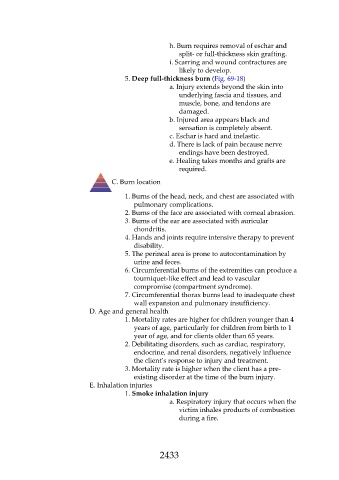Page 2433 - Saunders Comprehensive Review For NCLEX-RN
P. 2433
h. Burn requires removal of eschar and
split- or full-thickness skin grafting.
i. Scarring and wound contractures are
likely to develop.
5. Deep full-thickness burn (Fig. 69-18)
a. Injury extends beyond the skin into
underlying fascia and tissues, and
muscle, bone, and tendons are
damaged.
b. Injured area appears black and
sensation is completely absent.
c. Eschar is hard and inelastic.
d. There is lack of pain because nerve
endings have been destroyed.
e. Healing takes months and grafts are
required.
C. Burn location
1. Burns of the head, neck, and chest are associated with
pulmonary complications.
2. Burns of the face are associated with corneal abrasion.
3. Burns of the ear are associated with auricular
chondritis.
4. Hands and joints require intensive therapy to prevent
disability.
5. The perineal area is prone to autocontamination by
urine and feces.
6. Circumferential burns of the extremities can produce a
tourniquet-like effect and lead to vascular
compromise (compartment syndrome).
7. Circumferential thorax burns lead to inadequate chest
wall expansion and pulmonary insufficiency.
D. Age and general health
1. Mortality rates are higher for children younger than 4
years of age, particularly for children from birth to 1
year of age, and for clients older than 65 years.
2. Debilitating disorders, such as cardiac, respiratory,
endocrine, and renal disorders, negatively influence
the client’s response to injury and treatment.
3. Mortality rate is higher when the client has a pre-
existing disorder at the time of the burn injury.
E. Inhalation injuries
1. Smoke inhalation injury
a. Respiratory injury that occurs when the
victim inhales products of combustion
during a fire.
2433

